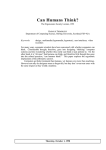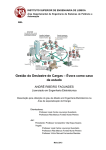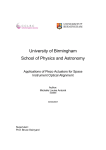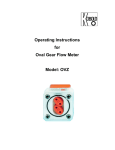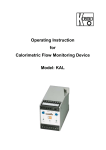Download Precision Motion Control with Variable Speed AC Drives Using PLC
Transcript
International Journal of Recent Technology and Engineering (IJRTE) ISSN: 2277-3878, Volume-2, Issue-6, January 2014 Precision Motion Control with Variable Speed AC Drives Using PLC Kiran Kumar GR, Shivakumar LN, Marulasiddappa HB Abstract— A new scheme for precision motion control of AC motor driving a load is proposed. Traditionally, DC motors had been preferred in applications requiring control of speed and position at close tolerance. The high torque bandwidth over the complete speed range available with a separately excited DC machine was ideal for such applications. However, the cost of manufacturing and maintaining a DC motor and the associated control gear is high. The recent developments of technology to control speed of AC motors with almost constant torque over the entire speed range from zero-speed to rated speed, has made the option of using AC drives in place of DC motor drives cheaper and virtually maintenance free. The DC motor, for precise control of speed, typically uses analog or digital tacho-generator for speed feedback. In the proposed scheme, the drive system based on PWM AC drive, direct speed feedback has been eliminated adopting “Open-Loop Vector Control”. This is achieved by a combination of a programmable logic controller (PLC) and variable speed AC drive systems along with encoders. Index Terms— Programmable Logic Controller (PLC), AC Drive, Encoders, Ethernet. 20-COMM-E, DPI, TCP/ IP.Proximity sensors.HMI,SCADA It also enables, using high-end touch-screen human machine interface, for the operator to set and modify cutting parameters, display of data and alarms in real time, and also uses industrial ethernet networking for machine control. The advantages are elimination of cumbersome wiring between PLC and drive controllers and maintenance problems associated with hardwired electrical controls. Recently Jahns and Acernely have reported on automation and motion control of torch cutting machine torches, and its carriage [1]. Highlighting scope, need, and advantages of motion control. The topic of this article involves the complete automation of torch cutting machine with a controller like PLC, CNC, and drives to provide automation with accuracy. Hofheim wallau reported on the performance of torch cutting machine which is used for sub-dividing the cast steel bloom into preselected lengths, for separating warm and cold bloom [2]. The desired piece lengths can be indicated by the operator via the length measuring equipment, which allows the preselected piece lengths to be separated from the bloom. The structure and the mechanical arrangement of the sample torch cutting machine are suited to the working environment, in order to suit the high demands on the equipment by steel mills. Lin and Hu have reported on the basic idea required for torch cutting machine control [3]. The basic idea for the proposed work is carried out by using industrial programmable controller, so as to control variable speed AC drive systems for high speed applications; here the controller acts as a master and connected with encoders to provide positional feedback. In order to have better control for positioning, speed, motors, along with drives are interfaced with the PLC. The user based part program decoded by the main processor PLC, provides the desired profile with the control being transferred to cutting machine PLC and drives as and when required. Special measuring devices like encoders, sensors being interfaced with the PLC through independent controllers provide more accuracy. Patrick reported on the application of AC motors with variable speed AC drives for high speed application [4]. The speed of a motor can be controlled by using some type of electronic drive equipment, referred to as variable or adjustable speed drives, which converts AC to DC, and then through various switching techniques inverts the DC into a variable voltage, variable frequency output. Standard AC motors are designed to operate at a fixed voltage and frequency. The information that is provided on the motor nameplate is referred to as the motors base rating point, which defines the reference operating point at a specified voltage, speed, and power. Zeroug have reported on encoder application over ethernet networking for machine automation [5]. The option for feedback depends on the sensors used in the drive. If the position sensor used is analog, like a resolver, a potentiometer, then an analog input channel has to be used. I. INTRODUCTION A system with a feedback controller will attempt to drive the system to a state described by the input, such as velocity. The motion controller will accept commands or other inputs to generate a motion profile using parameters such as distance to move, maximum acceleration and maximum velocity. The main objective of this project work is to apply the principles and Technology of motion control to an automatic bloom cutting machine, The bloom cutting machine, manufactured by a company called GEGA, Germany requires precise, coordinated motion of the machine elements to cut the hot steel blooms in a continuous steel caster. The bloom keeps moving down the caster and the cutting machine has to move along with the bloom and cut it in specified lengths while in motion. The relative velocity between the moving bloom and the cutting torches has to be zero. The measurement tolerance of the cut lengths is +/- 5 mm and two cutting torches are employed for cutting simultaneously. This is achieved by a combination of a programmable logic controller (PLC) and variable speed AC drive systems. PLC incorporating advanced IT functions such as communication and floating point mathematical functions, has been used. It enables high speed pulse counting and mathematical manipulation of inputs from incremental encoders. Manuscript received January, 2014. Mr.Kiran Kumar GR., Electrical and Electronics Engineering Department, VTU/ PESITM, Shimoga, India. Mr.Shivakumar LN, Electrical and Electronics Engineering Department, VTU/ PESITM, Shimoga, India. Mr.Marulasiddappa HB, Electrical and Electronics Engineering Department, VTU/ PESITM, Shimoga, India. 43 Published By: Blue Eyes Intelligence Engineering & Sciences Publication Pvt. Ltd. Precision Motion Control with Variable Speed AC Drives Using PLC On the other hand, if the sensor used is a shaft angle encoder, then a digital input channel is to be used, in which case, the pulse counting has to be done by the module. Else the counter function module and the count valve read from it via ethernet networking. The problems faced by using this conventional cutter are: 1) Jerky movement. 2) Poor efficiency. 3) Requires keen observation from manual operator. 4) More time consumption. The above problems can be overcome by using high performance machinery drive, interfaced with a PLC which is pre programmed. The motor which is connected to the torch car (TC) is controlled through Allen Bradley drive (powerFlex-70). The Proximity sensors are used to sense the position of TC, and its carriage. The TC movement is controlled through drive and PLC. The required application program will be loaded in PLC, and the desired parameters will be set in the drive. The speeds, acceleration /decelerations times etc. are set in drive parameters, the commands will be given to drive from PLC. In turn, the drive will control the motion of torch cars and its carriage through the motors, in turn the motors are linked with the drives. The objectives of the present scheme are to: 1) To automate the movement of the torch cars. 2) To control the motor speed of TC by the use of an Allenbradley, powerflex-70 AC drive and PLC. 3) To reduce the man power. 4) To get accurate results and increased production with high efficiency. 5) To reduce the cost of troubleshooting and maintenance. is controlled by operating system software, which is a group of supervisory program that are loaded and stored permanently in the PLC’s memory by PLC manufacturer. Such software used here is RSLOGIX5000. Digital I/O modules: These are the modules which transfers the information between CPU and processor peripherals as sensors, transducers, and actuators. In the proposed project digital I/O module is used for transformation of information between CPU and processor peripherals like sensors, gas and pressure switches. Digital input module converts the external binary signals from the process to the internal digital signal level of programmable controllers. Digital output module converts the internal signal level of programmable controllers into the binary signal level required externally by the process. Digital I/O module signal states are “0” and “1” only. Thereby PLC is a main centralized control unit in this automation system.PLC takes sensor and encoders signal as position of torch cars and machine carriage, ladder logic program technique is used to write the program. This signal is given as position state input to the program, which is running in PLC, this program according to reference input constraints and logic gives the output signal, those signals act as commands clock wise/counter clock wise, slow, fast to the drive. B. Allen-Bradley drives (PowerFlex-70): Drives according to the commands given by PLC, its going control the movement of torch cars, and GEGA carriage through the permanent magnet synchronous motors and induction motor respectively. The drives used are 3 in numbers, 1 for machine travel, and other 2 for torch car travel, one for each. Required power supply is 3-phase, 415V, AC. The parameters will be set in the drive for example, minimum speed, maximum speed, torque etc, while configuring the drives. These values are like the reference values and actual values (through PLC from HMI) will be compared with these values and if they match, further action takes place. II. PRECISION MOTION CONTROL The proposed controller for automatic bloom cutting machine motion control is as shown in Fig.1. is a combination of different devices like PLC, drives, encoders, HMI, SCADA terminal and synchronous motors which are interconnected via TCP/IP protocol over ethernet network. The functional description of each block is as described below C. Ethernet and Encoders: Ethernet (1756ENBT) is the most popular and most widely deployed network technology in the world, which is a physical media which builds communication between PLC and drives and also between PLC and HMI as shown in Fig.1. Encoders (Hengstler) are an electromechanical device that can measure motion or position. Required power supply is 10-30V, DC. Encoders mounted on TC-1, TC-2, generate a pulse as and when the TC-1, TC-2 moves, its evaluation will be done by counters in the PLC. Its technical data is discussed in encoder section of the hardware implementation part. A. Allen Bradley PLC (1756 ControlLogix): Several racks of PLC are as shown in Fig. 1. Power supply: This module can be built into the PLC processor module or can be an external unit. Common voltage required by the PLC is 24V, DC. PLC is powered by standard commercial AC power lines. However PLC components such as CPU and memory utilize 5v or another level of DC power supply. The PLC power supply converts AC power into DC power to support these components of the PLC. Ethernet modules: These are the modules used to build a communication between PLC and HMI, PLC and AC drives, etc, from where PLC gets reference parameters, such as initial, normal, and cutout speed, etc. CPU module: CPU which is the brain of a PLC, and this is the main computing module, where ladder logic and other application program are stored and processed. Here in the proposed project, the ladder logic program, is a set of instruction written by a PLC programmer, are dumped into CPU from the main PLC processor via ethernet hub. Scanning function allows the PLC to execute the application program as specified by the programmer. CPU transfers program and data between itself and the programming terminal. A PLC’s CPU D. HMI (panelview1000): Works with the supply voltage of 230V, AC. Programming software for HMI is “Factory talk view machine edition”. The PLC gets the reference parameter from HMI, as operator will pre-set it in HMI before operation. HMI communicates with PLC using TCP/IP protocol over ethernet. E. Sensors: These are inductive proximity sensors & give a signal, when the TC-1, TC-2 and carriage reaches near the sensor, and these are the main inputs to PLC. These give digital input to PLC, once the metal (here in this case is the torch cars and carriage) comes near sensor, due to induction an emf is 44 Published By: Blue Eyes Intelligence Engineering & Sciences Publication Pvt. Ltd. International Journal of Recent Technology and Engineering (IJRTE) ISSN: 2277-3878, Volume-2, Issue-6, January 2014 induced in it and hence gives a high signal to PLC. If the metal moves away from it, then sensor gives a low signal. Based on the sensor signal to PLC, the movement of torch cars and machine carriage can be controlled along with the help of encoders. F. SCADA terminal: Terminal where standard reference cutting parameters are entered via operator, this is to be loaded into auto cutter PLC, through Ethernet hub. Fig.2. Complete automation system for Bloom caster The GEGA cutter PLC panel implemented is as shown in Fig.6.works with 24V, DC supply, where ladder logic application program and standard cutting parameters from main processor PLC and SCADA terminals respectively are dumped. Also it is supported by ethernet card, so that to link PLC with other devices in a network and to transmit signals required for controlling purpose. Fig.1. Proposed precision control III. IMPLEMENTATION OF THE PROPOSED START UP METHOD After configuring the powerflex-70 AC drive, it is installed at the bloom cast chamber. The required signals are provided from the PLC, which in turn receives a command signals from main processor PLC, SCADA terminal, and HMI. The different devices are interconnected over ethernet network and its communication via TCP/IP protocol. The complete automation system for bloom casting process is as shown in Fig.2. By connecting a drive to PC via Ethernet port, it is now easy to view and change different parameters in the monitor file, motor control file, and speed command file of the drive as per application requirement.AC drive works with 3-phase, 415V, AC supply. SMART start up is used to set up most commonly used function such as minimum speed, maximum speed, acceleration and deceleration time, etc with the help of key pad on the front panel of drive. A 20-COMM-E adapter which is mounted on the back plane of AC drive supports ethernet port, to connect a drive to a network and to receive a signal from other devices connected to the network, and DPI connector, to carry those signals from network to internal logic circuitry of drive via internal interface cable. Drive configuration stage is as shown in Fig.3. DPI connector is as shown in Fig.4. The panel implemented is as shown in Fig.5. Fig. 3 configuring stage of drive 45 Published By: Blue Eyes Intelligence Engineering & Sciences Publication Pvt. Ltd. Precision Motion Control with Variable Speed AC Drives Using PLC IV. CONCLUSION This paper gives an insight into the latest automation technology, and its implementation into the real time system. The final metallurgical process in the manufacture of required dimensions of steel block is accomplished by completely automated solution. Coordination of different devices like PLC, drives, encoder, and motors over an Ethernet network, has made the task of steel bloom cutting an easy task, with less time consumption and reduced man power; resulting in a high efficiency. The development of technology to control speed of AC motors with almost constant torque over the entire speed range has made the option of using AC drives system in place of DC motor drives. In addition, the use of industrial ethernet networking for machine control, provide the benefits of eliminating a cumbersome wiring between PLC and drive controllers, and maintenance problems associated with hardwired electrical controls. Furthermore, the conversion of complex control structure requirements into logics, and in providing graphical user interface front end panel for operating, control, and monitoring of these logic operations has greatly simplified the operator’s work. The complete integrated system has been tested and it is used in the main production illustrating the effectiveness and correctness of the system. Fig.4 DPI connector Implemented panelview-1000 plus (HMI), from where operator can provide different cutting parameters like initial cutting speed, normal cutting speed, etc to PLC is as shown in Fig.7.requires 230v, AC supply and works with “Factory talkview machine software”. ACKNOWLEDGMENT At the outset, we wish to express our deep sense of gratitude to Mr. Surajith Mishra, Assistant general Manager, VISL, Badravathi, for his moral support from the beginning till the end of this work without which it would not have been possible for us to accomplish the work successfully, and also we proceed our thanks to our PESITM Faculties for their valuable suggestions throughout this work. Fig. 5 Drive panel view for experimental set up REFERENCES T.M.Jahns., P.P.Acarnley, “Motion control of torch cutting machine with controller system,” IEEE Trans on industry applications, Vol.82, issue 3, PP.441-450, may-June 1996. [2]. Hofheim wallau, “Torch cutting machine for smooth cutting,” IEEE, Vol.84, STR.3, D-65719. [3]. R.L.lin, M.T.Hu, “Auto torch cutting system using PLC and variable speed AC drives for high speed application,” IEEE conference on steel plant application, Vol.1, PP.637-642, 2001. [4]. Patrick A. Brady, “Application of AC motors with variable speed drive,”IEEE, Vol.89, 978-1-4245, 2009. [5]. H.Zeroug. “Encoder application over Ethernet networking in machine automation,”IEEE, Vol.68, PP464, Jun 1996. [6]. Barton suer, “Ethernet networks,” technical description manual, Vol.5. [7]. Allen-Bradley, “Powerflex-70 adjustable frequency AC drives,” user manual, Rockwell automation. [8]. “Encoder application overview,” Hengstler operator manual. [9]. Allen-Bradley “1756-controllogix,” Allen-Bradley publication may 1989. [10]. Allen-Bradley “20-COMM-E adapter”, user manual, Allen-Bradley publication, may 1996. [1]. Fig. 6 PLC panel view for experimental set up Kiran Kumar GR received his B.E. degree (Electrical Engineering) in 2009 from VTU. M.Tech. (Computer Application in Industrial Drives) in 2011 from VTU. He joined the department of Electrical & Electronics Engineering HMSIT, in 2011 and is currently Assistant Professor in PESITM, Shimoga, His research interests are in the area of high voltage, control systems. He has published several papers in national journals. He is a life time member of MISTE. Shivakumar LN received his B.E. degree (Electrical Engineering) in 2008 from VTU. M.Tech. (Power Systems) in 2010 from VTU. He joined the Fig. 7 Touch screen HMI panel view for experimental set up 46 Published By: Blue Eyes Intelligence Engineering & Sciences Publication Pvt. Ltd. International Journal of Recent Technology and Engineering (IJRTE) ISSN: 2277-3878, Volume-2, Issue-6, January 2014 department of Electrical & Electronics Engineering PESITM, in 2010 and is currently Assistant Professor in PESITM, Shimoga, His research interests are in the area of power system, control systems. He has published several papers in national journals. He is a life time member of MISTE. Marulasiddappa HB received his B.E. degree (Electrical Engineering) in 2006 from VTU. M.Tech. (Power Electronics) in 2008 from VTU. He joined the department of Electrical & Electronics Engineering PESITM, in 2008 and is currently Assistant Professor in PESITM, Shimoga, His research interests are in the area of Power Electronics, control systems. He has published several papers in national journals. He is a life time member of MISTE. 47 Published By: Blue Eyes Intelligence Engineering & Sciences Publication Pvt. Ltd.









